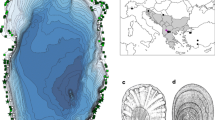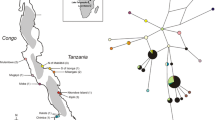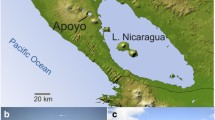Abstract
Lakes Baikal, Tanganyika and Malawi have similar origins, are physiographically similar, and of similar size. The hydrological regime of Baikal is, however, very different from that which prevails in its African sisters. Apart from being much cooler, it differs fundamentally in being oxygenated to all depths while the two great African rift lakes possess only a relatively thin oxygenated surface layer and have vast oxygenless, and therefore azoic, abyssal regions. Nevertheless, like Baikal, they have rich endemic faunas.
That these faunas originated largely by intralacustrine speciation and not by multiple invasion is now well established. They provide some of the world's most spectacular examples of species flocks, and some groups display what has been aptly described as explosive speciation. Certain features, and especially the adaptive radiation, of some of the groups involved, are noted. Comparisons between lakes are illuminating. Some species flocks, such as those of amphipods, sponges and turbellarians of Baikal and the atyid prawns and potamid crabs of Tanganyika, have no counterparts in the other lakes. Other groups, such as the prosobranch gastropods, ostracods and harpacticoid copepods of Baikal and Tanganyika, and the fishes of all three, involve representatives of the same major group, though often of different families or even higher taxonomic categories.
That allopatric speciation has been involved is universally acknowledged but the problems posed by species multiplication in deep water in L. Baikal have led to suggestions that sympatric speciation could have played a part. Notwithstanding the difficulties, it is suggested that the process can be explained without invoking the assistance of the sympatric model.
The faunas of these lakes provide immense fields for investigation and enormous intellectual challenges. While each is an entity in itself, comparative studies may be particularly enlightening.
Similar content being viewed by others
References
Barnard, J. L. & C. M. Barnard, 1983. Freshwater Amphipods of the world. Mt Vernon. Hayfield Associates.
Bazikalova, A. Y., 1945. Amphipods of Lake Baikal. Trudy Baik. limnol. Stn Acad. Sci. U.S.S.R. 11: 5–440 (In Russian: French Summary).
Brooks, J. L., 1950. Speciation in ancient lakes. Quart. Rev. Biol. 25: 30–60, 131–176.
Capart, A., 1952. Le milieu geographique et geophysique. Explor. hydrobiol. Lac Tanganika (1946–1947) Inst. roy. Sci. nat. Beige 1: 1–27.
Dorogastaisky, V. C., 1923. Distribution verticale et horizontale de la faune du lac Bajcal. Rec. de trav. des Proff. de l'Univ. d'Etat a Irkoutsk Sci. Nat. 4: 102–131 (In Russian).
Fryer, G. & T. D. Iles, 1972. The cichlid fishes of the Great Lakes of Africa; their biology and evolution. Edinburgh. Oliver & Boyd.
Kozhov, [M] M., 1963. Lake Baikal and its life. The Hague. Junk.
Leloup, E., 1953. Gastéropods. Explor. hydrobiol. Lac Tanganika (1946–1947) Inst. roy. Sci. nat. Beige 3: (Fasc. 4) 1–273.
Marsh, A. C., 1981. A contribution to the ecology and systematics of the genus Petrotilapia (Pisces: Cichlidae) in Lake Malawi. M. Sc Thesis. Rhodes University, Grahamstown.
Marsh, A. C., A. J. Ribbink & B. A. Marsh, 1981. Sibling species complexes in sympatric populations of Petrotilapia Trewavas (Cichlidae, Lake Malawi). Zool J. Linn. soc. 71: 253–264.
Myers, G. S., 1960. The endemic fish fauna of Lake Lanao, and the evolution of higher taxonomic categories. Evolution 14: 323–333.
Owen, R. B., R. Crossley, T. C. Johnson, D. Tweddle, I. Kornfield, S. Davison, D. H. Eccles & D. E. Engstrom, 1990. Major low levels of Lake Malawi and their implications for speciation rates in cichlid fishes. Proc. R. Soc. Lond. B 240: 519–553.
Rome, R., 1962. Ostracodes. Explor. hydrobiol. Lac Tanganika (1946–1987) Inst. roy. Sci. nat. Belge 3: (Fasc. 8) 1–305.
Ribbink, A. J., B. A. Marsh, A. C. Marsh, A. C. Ribbink & B. J. Sharp, 1983. A preliminary survey of the cichlid fishes of rocky habitats in Lake Malawi. S. Afr. J. Zool. 18: 147–310.
Sage, R. D., P. V. Loiselle, P. Basasibwaki & A. C. Wilson, 1984. Molecular versus morphological change among cichlid fishes of Lake Victoria. In Evolution of fish species flocks. (Eds. Echelle, A. A. and Kornfield, I.) pp 185–197. Orono. Univ. of Maine.
Sars, G. O., 1910. Zoological results of the Third Tanganyika Expedition, 1904–1905. Report on Ostracoda. Proc. zool. Soc. Lond. 1910: 732–760.
Scholtz, C. A. & B. R. Rosendahl, 1988. Low lake stands in Lakes Malawi and Tanganyika, East Africa, delineated with multifold seismic data. Science, Washington. 240: 1645–1648.
Smith, G. R. & T. N. Todd, 1984. Evolution of species flocks of fishes in North Temperate lakes. In Evolution of fish species flocks. (Eds. Echelle A. A. & Kornfield I) pp 45–68. Orono. Univ. of Maine.
Starobogatov, Y. I. & T. Y. Sitnikova, 1989. Speciation and endemic evolution of Baikalian molluscs. Abstract of paper presented at First Vereshchagin Conference. pp 24–25.
Yonge, C. M., 1938. The prosobranchs of Lake Tanganyika. Nature, Lond. 142: 464–466.
Author information
Authors and Affiliations
Additional information
The substance of this paper was presented as a lecture at the First International Baikal Vereshchagin Conference held in Listvyanka, Irkutsk Region, U.S.S.R. in October 1989.
Rights and permissions
About this article
Cite this article
Fryer, G. Comparative aspects of adaptive radiation and speciation in Lake Baikal and the great rift lakes of Africa. Hydrobiologia 211, 137–146 (1991). https://doi.org/10.1007/BF00037369
Received:
Accepted:
Issue Date:
DOI: https://doi.org/10.1007/BF00037369




